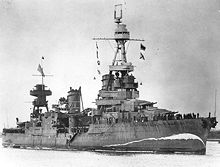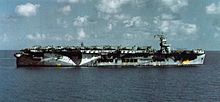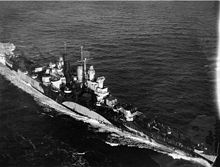- Ship camouflage
-
 USS Drayton wearing measure 1.
USS Drayton wearing measure 1.
 USS Northampton wearing measure 5.
USS Northampton wearing measure 5.
 USS Alabama wearing measure 16.
USS Alabama wearing measure 16.
 USS Santee wearing measure 17.
USS Santee wearing measure 17.
 USS Pennsylvania wearing measure 21.
USS Pennsylvania wearing measure 21.
 USS Concord wearing measure 22.
USS Concord wearing measure 22.
 USS Miami wearing measure 32, Design 1d.
USS Miami wearing measure 32, Design 1d.
 USS Duluth wearing measure 32, Design 11a.
USS Duluth wearing measure 32, Design 11a.
 USS Saratoga wearing measure 32, Design 11a.
USS Saratoga wearing measure 32, Design 11a.
 USS Hancock wearing measure 32, Design 3a.
USS Hancock wearing measure 32, Design 3a.
 USS Flint wearing measure 33.
USS Flint wearing measure 33.
Ship camouflage is a form of military deception in which a ship is painted in one or more colors in order to obscure or confuse an enemy's visual observation. There are three types of marine camouflage that have been used: blending or crypsis, in which a paint scheme attempts to hide a ship from view; deception, in which a ship is made to look smaller, or that it has a different speed or heading; and disruption, a chaotic paint scheme which tries to confuse any estimate of distance or direction.
Contents
Prior to World War One
The first recorded instance of ship camouflage was in the years 56–54 BC during the Gallic Wars, carried out by Julius Caesar who sent his speculatoria navigia (scout ships) to gather intelligence along the coast of Britain, the ships painted entirely in green, their crews dressed in green.[1]
In the Age of Sail, deception was often used by ships, and paint was applied ad hoc by ships' captains for temporary tactical advantage. A ship might be painted to look like another, it might have its cannon ports hidden by painted canvas to look harmless, or it might have additional cannon ports painted on to appear more powerful. As one example among many, for one of his battles during 1778–1782, American privateer Jonathan Haraden hid the guns of his ship the General Pickering, to appear as if it were a slow merchant ship. Haraden allowed his ship to be approached at close range by a much faster British privateer, then he quickly pulled the painted canvas away and delivered a full broadside, capturing the enemy.[2]
In the American Civil War, camouflage paint was applied by both sides during the Union blockade of 1861–1865. Blockade runners aiding the Confederates sometimes painted their ships all in mist-gray, to hide themselves in coastal fog.[3][4] One Union blockade crew may have painted their rowboat white, and its oars, and wore white clothing for a night reconnaissance patrol up an enemy-held river.[1]
In the 1890s, German and French fighting ships were being painted gray.[5] American interest in ship camouflage was given official funding in 1898 during the Spanish–American War when white, light gray, and medium gray paint schemes were evaluated for their ability to hide a ship as seen against the distant sky on the horizon.[6] Artist Abbott Handerson Thayer investigated countershading color schemes to disrupt natural shadows.[7] British ships began being painted gray in 1903.[5] In 1913, American camouflage experiments included a submarine painted in a three-color pattern of broad vertical stripes designed by William Mackay, using white stripes to separate green and blue stripes.[1]
First World War
At the beginning of World War I, the increasing range of naval guns, and the great fear of high-speed, long-range torpedoes used against warships and merchant ships caused a significant increase in the use of ship camouflage.[5]
These schemes were used on merchant ships and smaller warships. Battlefleets continued to be painted in various shades of gray.
- Admiralty dazzle camouflage was intended as an anti-submarine measure for merchant ships sailing independently.
- Mackay Low Visibility System was violet with red or green patches or speckles.
- Mackay Disruptive/Low Visibility System had solid blue on the lower hull, with green, orange and white in bold, undulating shapes above.
- Toch Disruptive/Low Visibility System had parallel, curving diagonal stripes of gray, green, purple, red, brown and white. Used for troop transports.
- Warner Disruptive Dazzle System had large, curving shapes in red, blue and green, mixed in with white or gray shapes. Used for troop transports
- USN Dazzle Painting was similar to the Admiralty system, but used medium size polygons and more muted colors.
Second World War
United States
In 1935, the United States Navy Naval Research Laboratory began studies and tests on low visibility camouflage for ships. Research continued through World War II to (1) reduce visibility by painting vertical surfaces to harmonize with the horizon and horizontal surfaces to blend with the sea, or (2) confuse identity and course by painting obtrusive patterns on vertical surfaces. Some camouflage methods served both purposes:[8]
- Measure 1 – Dark Gray System was dark gray overall except for white structures above bridge level.[8]
- Measure 2 – Graded System was dark gray on the hull and light gray on the superstructure and turrets.[8]
- Measure 3 – Light Gray System was light gray overall.[8] Replaced by Measure 23.
- Measure 4 – Black System for Destroyers was black overall.[8] This was intended for destroyer night operations but it was found that even on very dark nights, black ships were more noticeable than gray ones.
- Measure 5 – Painted Bow Wave was a false bow wave to give the impression of high speed at all times.[8]
- Measure 6 – Light Cruiser to Simulate Heavy Cruiser was used to make a Brooklyn- or St. Louis-class cruiser resemble a New Orleans-class cruiser.[8]
- Measure 7 – Old Cruiser to Simulate Old Destroyer was used to make an Omaha-class cruiser resemble a Clemson-class destroyer.[8]
- Measure 8 – Modern Cruiser to Simulate Modern Destroyer was used to make a Brooklyn- or St. Louis-class cruiser resemble a two-funnel destroyer. This measure was discontinued after causing station-keeping confusion among ships operating in formation.[8]
- Measure 9 – Black System for Submarines was black overall for submarines and is still in use.[8]
- Measure 10 – Gray System for Submarines was ocean gray overall for submarines that operated beyond the range of enemy aircraft.[8]
- Measure 11 – Sea Blue System was sea blue overall, including the decks. It was used in the Pacific and Mediterranean for concealment from aircraft. During the Battle of the Coral Sea and the Battle of Midway, ships wearing Measure 11 came under attack less often than ships wearing Measure 12. On the advice of United States aviators, the Sea Blue color was darkened to navy blue and designated Measure 21.[8]
- Measure 12 - Graded System with sea blue low on the hull below the first continuous deck, with ocean gray above that. The top of the masts were painted haze gray. The only visible difference to the later mainly used Measure 22 was that the navy blue colour was painted parallel to the main deck, whereas with Measure 22 it was painted parallel to the waterline.[9]
- Measure 12 (Modified) – Graded System with splotches was sea blue low on the hull, ocean gray at about the main deck level, and haze gray above that. With experience, sea blue was substituted for the dark gray, and the Sea Blue was darkened to Navy Blue. During low visibility conditions, the Navy Blue was a near match to the water, and the splotchy gray blended well with the horizon. This measure was used widely in the Atlantic and Pacific until early 1943. This measure was found less effective against aerial observation during the early carrier aircraft battles of Coral Sea and Midway, and Measure 11 and its replacement Measure 21 became preferred in the Pacific.[8]
- Measure 13 – Haze Gray System was haze gray overall. This was the least used solid color measure during World War II.[8] This was found to provide reasonable protection in the widest range of conditions, and became a standard paint scheme after the war under assumed conditions of radar observation.
- Measure 14 – Ocean Gray System was ocean gray overall.[8] This was used on supply ships, and became a standard paint scheme after the war.
- Measure 15 was an irregular patchwork of greens, whites, and other colors. It was used in the summer and autumn of 1942, and was replaced by Measure 33.
- Measure 16 – Thayer System was white with large polygonal patches of light sea blue (called Thayer Blue.) This measure was most useful in Arctic latitudes with extended twilight and frequent fog and cloud cover. Purity of color was important for full realization of the Purkinje effect where some colors appear lighter and some appear darker at low levels of illumination. Darkening the pattern increased course deception, but increased visibility at night and in haze. This measure was used extensively through 1943 and early 1944 in North Atlantic and Aleutian waters.[8] Replaced by Measure 33.
- Measure 17 was a dazzle pattern of blues, grays and whites. It was only applied to three ships, USS Santee, USS Augusta, and USS Chicopee.
- Measure 21 – Navy Blue System was navy blue overall, including the decks. This measure was used extensively in the western and southern Pacific from mid-1942 through 1945 to minimize detection and identification by enemy aircraft. Measure 21 also proved effective under artificial illumination during night actions. Upper surfaces of aircraft operating from carrier decks were painted a similar shade of blue. Sailors were ordered to wear dungarees rather than white uniforms when topside.[8] This largely replaced measure 11.
- Measure 22 – Graded System was navy blue low on the hull below the first continuous deck (painted parallel to the waterline), with ocean gray above that. This bold contrast on a horizontal line near the horizon reduced visibility to surface observers and created the illusion of greater range. This measure largely replaced Measure 12 where aerial observation was unlikely. This system was considered most effective for gunnery engagements with surface units or shore batteries. This measure was used in the Atlantic and European coastal waters from the end of 1942 through the end of World War II. It was worn by shore bombardment ships in the Pacific from late 1944 after the destruction of Japanese naval aviation capability at the Battle of the Philippine Sea.[8]
- Measure 23 – Light Gray System was light gray overall, used by anti-submarine vessels in the tropics or subtropics.[8] Replaced by Measure 33.
- Measure 31 – Dark Pattern System was an army-style pattern of greens, browns and grays used by smaller ships like landing craft and PT boats that operated close to shore.[8]
- Measure 32 – Medium Pattern System was a mixture of obtrusive polygons in navy blue or black, against background polygons of lighter grays and greens. This measure emphasized mistaken identity and course deception to complicate submarine attack. Patterns were carried across the bow, and light gray was used aft to blend with the wake. This measure was based on the World War I dazzle system modified by observations in the western Pacific. Measure 32 was applied to most surface ships in Pacific during 1944 and 1945. Different patterns were devised for classes with large numbers of ships so the pattern would not identify the class of ship.[8]
- Measure 33 – Light Pattern System was a mixture of polygons in various grays and lighter greens.[8] This was very suitable for northern waters and replaced Measures 15, 16 and 23.
Except in measures 11 and 21, decks were a blue gray shade.
United Kingdom
Between the wars, British naval ships were generally dark gray in northern waters, and light gray in the Mediterranean or tropical waters. In the first year of the war British captains largely painted their ships as they saw fit. As the war continued, the Admiralty introduced various standardized camouflage schemes.
- Western Approaches Scheme was white with large polygonal patches of light sea blue or light sea green. This was very suitable for the North Atlantic.
- Mountbatten pink was invented by Captain Louis Mountbatten. Its effectiveness was much disputed.
- Admiralty Disruptive Patterns were a wide range of patterns in blues, grays and greens with mottled boundaries between the various color patches.
- Admiralty Standard Schemes were light gray overall, except for a sea blue patch low on the hull, either between the main gun turrets or the entire length of the hull. They were much like the American measure 22.
- Admiralty Alternative Scheme was a dark gray hull with light gray turrets and superstructure, like the American measure 2. It was popular in the Mediterranean.
- Home Fleet Destroyer Scheme was like the Western Approaches Scheme but used darker shades of blue and gray on the rear third of the ship, to assist in station-keeping.
British decks were usually dark gray.
An experimental coating able to change colour was tested on Royal Navy submarines. On suggestion by Professor Leslie Cromby, lead oxide was applied to the hull, enabling it to become black on application of a solution of sulphite and sea water for night operation. For day sailing, a solution of hydrogen peroxide and sea water would be applied, producing sulfate and returning the hull to a white colour desirable for diurnal conditions.[10]
The Royal Canadian Navy experimented with variable diffused illumination of one side of ships to match horizon light levels and minimize silhouettes during prolonged arctic twilight or aurora borealis.[8]
German Kriegsmarine ships before the Second World War were either light gray overall or had dark gray hulls. Many retained this scheme during the war. Others had dazzle camouflage, usually in combinations of pale gray, dark gray and sea blue. Smaller ships were painted a very pale gray to blend in with the mists of northern European waters. Larger ships often had their bows and sterns painted a different shade from the rest of the hull. German decks were a very dark gray.
Italian ships of Mussolini's navy retained its pre-war scheme of light gray overall for its smaller ships, but the larger units mostly had dazzle camouflage of dark gray, light sea blue, light sea green and light gray. Italian foredecks had a high-visibility pattern of red and white diagonal stripes so that their own aircraft would not attack them.
Japanese ships largely retained their pre-war dark gray paint scheme, although some major units like aircraft carriers changed to a dark sea green. Some aircraft carriers had their flight decks painted in a dazzle camouflage, but this seems to have been ineffective.
Soviet ships were dark gray overall, sometimes with medium gray upperworks.
The French Navy used light gray before the war and under the Vichy regime. Free French ships that operated with the British adopted one of the British schemes. Those that were refitted in American shipyards were usually repainted in the American measure 22.
Post World War 2
After the Second World War, the universal adoption of radar made camouflage generally less effective. However, camouflage might have helped United States warships avoid hits from Vietnamese shore batteries using optical rangefinders.[8]
-
A patrol boat of the Royal Norwegian Navy, in a splinter camouflage pattern.
-
Camouflaged Brazilian Navy riverboat.
-
Patrol boat in Indonesia (2006).
Citations
- ^ a b c Murphy, Robert Cushman (January 1917). "Marine camouflage". The Brooklyn Museum quarterly (Brooklyn Institute of Arts and Sciences) 4–6: 35–39. http://books.google.com/books?id=A1zXAAAAMAAJ&pg=RA2-PA35.
- ^ Eastman, Ralph M. (2004) [1928]. Some Famous Privateers of New England. Kessinger Publishing. pp. 17–18. ISBN 1417906766. http://books.google.com/books?id=47qAqAqUlawC&pg=PA18.
- ^ Haven, Kendall F. (2002). Voices of the American Civil War: Stories of men, women, and children who lived through the War Between the States. Libraries Unlimited. p. xiv. ISBN 156308905X.
- ^ Kenyon, J. Douglas (2008). Forbidden science: from ancient technologies to free energy. Inner Traditions; Bear & Company. p. 105. ISBN 1591430828.
- ^ a b c Cowley, Robert; Parker (2001). The Reader's Companion to Military History. Houghton Mifflin Harcourt. p. 68. ISBN 0618127429. http://books.google.com/books?id=qOEu4ALwR-IC&pg=PA68.
- ^ Stockbridge, Frank Parker (1920). Yankee ingenuity in the war. Harper. p. 317. http://books.google.com/books?id=-aAMAAAAYAAJ&pg=PA317.
- ^ Williams, 2001, p. 70
- ^ a b c d e f g h i j k l m n o p q r s t u v w x Sumrall, Robert F. "Ship Camouflage (WWII): Deceptive Art" United States Naval Institute Proceedings February 1973 pp.67–81
- ^ Stefan Terzibaschitsch Kreuzer der U.S. Navy. Koehler, Herford (Germany) 1984, p. 32. ISBN 3-7822-0348-8
- ^ Professor Martyn Poliakoff CBE FRS: Interview on the properties of lead. http://www.youtube.com/watch?v=2ERfPN5JLX8
- Williams, David (2001) Naval camouflage, 1914–1945 : a complete visual reference Naval Institute Press ISBN 1-55750-496-2
- Bement, Alon, United States Shipping Board (1919). "Principles Underlying Ship Camouflage". International Marine Engineering (Simmons-Boardman) 24: 90–93. http://books.google.com/books?id=PKQvAAAAYAAJ&pg=PP102.
External Links
Categories:- Ships
- Military camouflage
- Camouflage patterns
Wikimedia Foundation. 2010.



